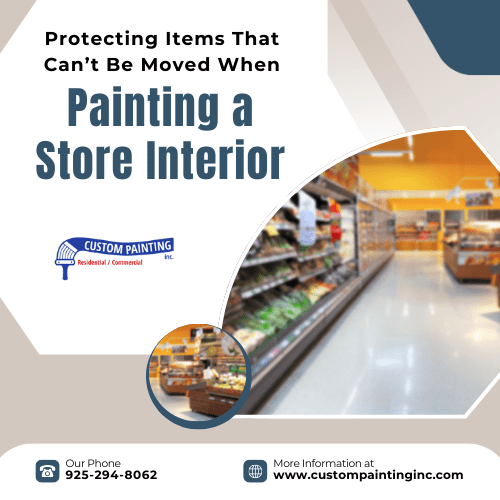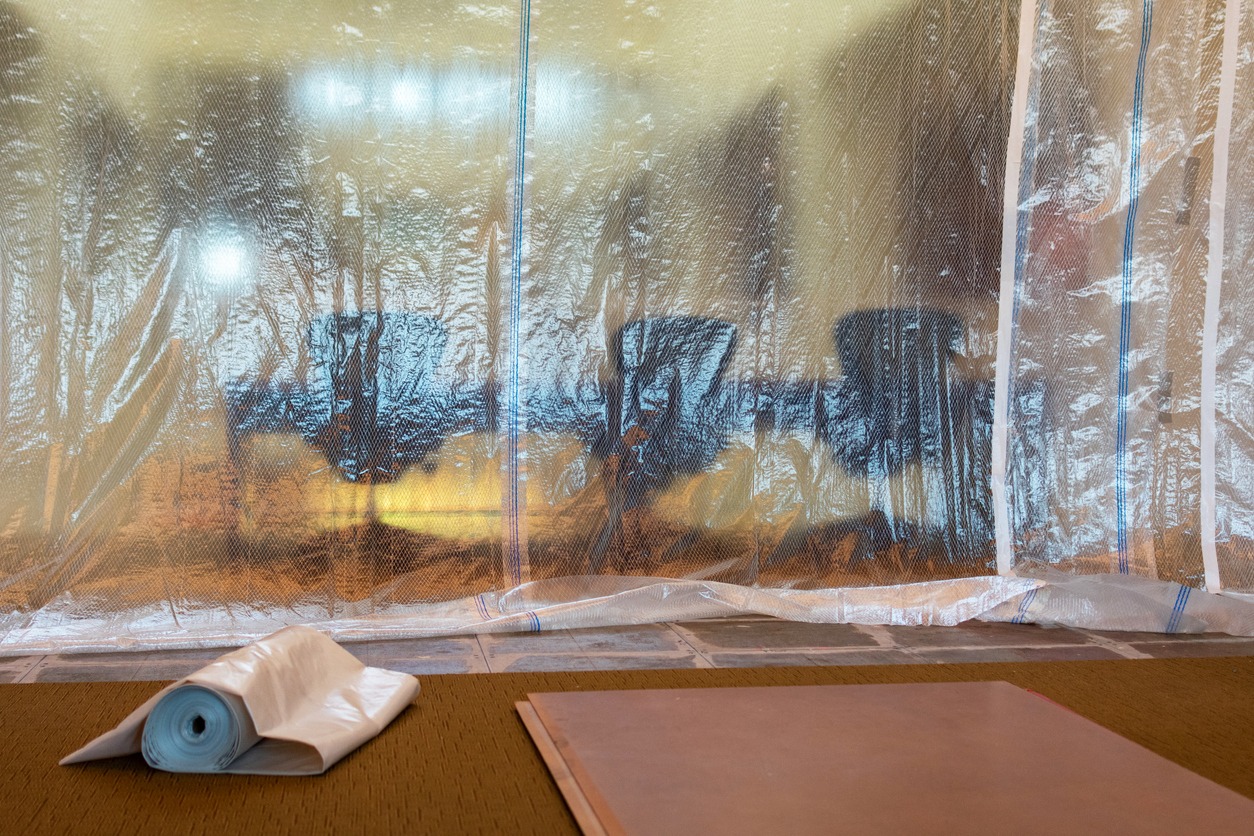Painting a store interior with large or fixed items presents challenges such as limited accessibility and the risk of damaging expensive fixtures, furniture, and equipment. Protecting these assets properly prevents paint splatters and drips, which can lead to costly repairs.
Professional painters safeguard surfaces using strategic techniques, such as drop cloths, plastic sheeting, and painter’s tape. They also plan their approach to ensure efficient painting around fixed items, minimizing disruption while maintaining the integrity of the store’s assets.
Identifying items that can’t be moved
When preparing to paint a store interior, identifying immovable items is crucial for an efficient process. Here are some common examples:
Common immovable items in store interiors
- Large display units or shelves: These fixtures often hold merchandise and cannot be easily relocated without significant effort or disassembly.
- Built-in counters or cabinets: Fixed counters and cabinetry provide essential service points and are integral to the store’s layout.
- Refrigeration units: These are essential for preserving perishable goods and are typically too bulky to move. They are found in grocery and convenience stores.
- Heavy equipment or machinery: Specialty stores may have large machinery (e.g., gym equipment, manufacturing tools) that cannot be easily relocated.
- Security equipment: Items like cameras, alarms, and other monitoring systems are often mounted and require careful planning to avoid disruption.
Importance of planning around fixed items
Planning around immovable items is essential to ensure a smooth painting process. It includes:
- Strategic layout: Developing a painting strategy that considers the locations of these items helps minimize disruptions and allows for efficient access to the areas that need painting.
- Surface protection: Covering and protecting immovable items from paint splatter and drips is necessary to maintain their condition.
- Clear communication: Informing staff and customers about the painting schedule and restricted access areas helps maintain safety and operational flow during the project.
Preparing the store for painting
- Initial walk-through: Conduct a thorough assessment to identify which items can be moved and which should remain in place. Doing so helps plan the painting process efficiently.
- Clearing the workspace: Remove smaller items, decorations, merchandise, and movable furniture to create an open workspace. This minimizes the risk of damage and allows easier access to walls and surfaces.
- Protective measures: Use drop cloths, plastic sheeting, and other protective materials to cover large or delicate surfaces, such as display cases, shelving, and floors. This safeguards against paint spills and splatters during the painting process.
Using proper protective materials
When painting a store interior, using proper protective materials is essential to achieve a professional finish while safeguarding surfaces and items.
- Drop cloths: Heavy-duty canvas is ideal for covering floors and high-traffic areas as it’s durable and absorbent, while lightweight plastic better protects delicate surfaces, such as counters, from spills.
- Plastic sheeting: Clear plastic sheeting protects display cases, shelves, and counters, allowing visibility while preventing paint damage.
- Painter’s tape: Carefully applying painter’s tape along edges near immovable objects, like wall edges and electrical outlets, ensures clean lines and prevents the paint from seeping into unwanted areas.
- Furniture covers: Using padded covers or specialized materials helps protect furniture from drips and splatters, maintaining the store’s aesthetics and preventing costly clean-up.
Protecting electronics and sensitive equipment
To protect electronics and sensitive equipment before painting a store interior, follow these guidelines:
- Protect devices: Cover cash registers, point-of-sale systems, and security monitors with plastic sheeting or drop cloths to prevent paint splatters.
- Wrap cords and plug outlets: Securely wrap cords with painter’s tape and unplug devices. Cover outlets to prevent paint from entering and ensure safe use after painting.
- Ensure ventilation: Proper ventilation is essential for any electronic equipment, allowing air circulation to prevent overheating during the painting process.
- Coordinate downtime: Work closely with the store owner to schedule downtime for sensitive electronics that may need to be temporarily turned off to avoid disruption or damage.
Masking and sealing techniques
- Masking around fixed items: Use painter’s tape to create clean edges around built-in shelves, counters, and display units. Press the tape down firmly to prevent paint from seeping underneath.
- Sealing off areas: For areas prone to paint splatter, like HVAC systems or ventilation ducts, cover them with plastic sheeting or newspaper. Use tape to secure the edges, ensuring they are well-sealed against paint particles.
- The importance of high-quality painter’s tape: Investing in high-quality painter’s tape is crucial for achieving clean lines. It helps prevent bleed-through, ensures a sharp finish between colors, and protects surfaces from unwanted paint marks.
Using specialty paints and tools for precision
Specialty paints: Low-splatter or quick-drying formulas are ideal for projects involving immovable objects, as they minimize mess and reduce waiting times for recoating or touch-ups. These features are beneficial when working in confined areas, preventing paint drips from damaging surrounding surfaces.
Smaller tools: Edging brushes and detail rollers allow for precise application in tight spaces, ensuring you can paint close to furniture or fixtures without causing damage. These tools provide greater control and accuracy, making them essential for achieving clean lines and neat finishes.
Application techniques: Spray painting is best for large, flat areas and achieving an even coat without brush marks. However, it requires careful masking of nearby items. Brush or roller application is better for detailed work or when precision is needed near delicate objects. It allows for more control over the paint application and minimizes overspray.
Minimizing disruption to store operations
Minimizing disruption to store operations during a painting project involves careful planning and execution:
- Scheduling: Plan the painting during off-hours or slower business periods to reduce customer and staff interference. Night or weekend work can help maintain normal business operations.
- Partitioning: Use temporary barriers, such as plastic sheeting or partitions, to section off areas being painted. Doing so protects customers and staff from paint fumes and minimizes noise and disruption in other areas of the store.
- Protecting high-traffic areas: Ensure that high-traffic areas are well-protected with drop cloths and barriers. Regularly clean these areas to maintain safety and aesthetics, ensuring customers can navigate the store comfortably without encountering hazards or unsightly messes.
Handling fragile or high-value items
When handling fragile or high-value items while painting a store interior, consider the following:
- Extra precautions: Remove or cover fragile items such as glass display cases, artwork, and decorative features with bubble wrap, blankets, or plastic sheeting to prevent damage from paint splatter or accidental bumps.
- Temporary barriers: Set up temporary barriers or enclosures using plastic sheeting or painter’s tape to isolate delicate items from the work area. Ensure these barriers are securely fastened and provide adequate protection from dust and paint.
- Coordination with management: Communicate with store management to identify irreplaceable items and develop a strategy for their protection. Discuss the timing of the painting project to minimize disruption and ensure that sensitive items are adequately secured.
Maintaining air quality and cleanliness during the painting process
Maintaining air quality and cleanliness during painting is essential for a safe and effective job. Here are some key points:
- Protecting fixed items: Cover fixed items with plastic sheets or drop cloths to shield them from dust and debris. Temporarily sealing off the area with painter’s tape and plastic can prevent paint particles from spreading.
- Ventilation solutions: Ensure good airflow by opening windows and doors or using fans to circulate air. Keep ventilation systems free from paint to avoid contamination, which can compromise air quality.
- Using low-VOC or eco-friendly paints: Choose low-VOC (volatile organic compounds) or eco-friendly paints to minimize fumes and harmful emissions, helping to maintain a healthier indoor environment during the painting process.
Aftercare: Cleaning up and ensuring everything is in place
- Post-painting cleanup: Carefully remove protective materials like drop cloths, tape, and plastic sheeting. Start from the top and work your way down to avoid dragging debris across painted surfaces. Peel the tape at a 45-degree angle to prevent damage.
- Inspection: Check all protected items for any paint splatters or damage. Use a damp cloth to wipe away minor spots, and touch up any affected areas with the original paint if needed.
- Touch-up tips: For precision, use a small brush or a paint pen in areas around immovable items (like cabinets or fixtures). Blend touch-ups with the surrounding paint by feathering the edges to ensure a seamless finish.
Conclusion
When painting a store interior, emphasize the importance of proper preparation, which includes thoroughly cleaning surfaces, repairing any damage, and ensuring all items are moved or covered. Use protective materials such as drop cloths and masking tape to safeguard fixtures, floors, and other fixed items. Working carefully around these assets will also help prevent damage and ensure a smooth, professional finish.
For professional, careful painting services that protect your store’s valuable assets, contact Custom Painting, Inc. today for a consultation! Call our team at 925-294-8062 or message us here. We are fully licensed, insured, and bonded for your protection, and we offer standard one-year workmanship (and one year on floor surfaces) on all our commercial paint projects.



